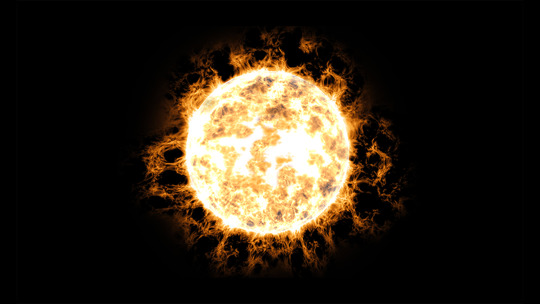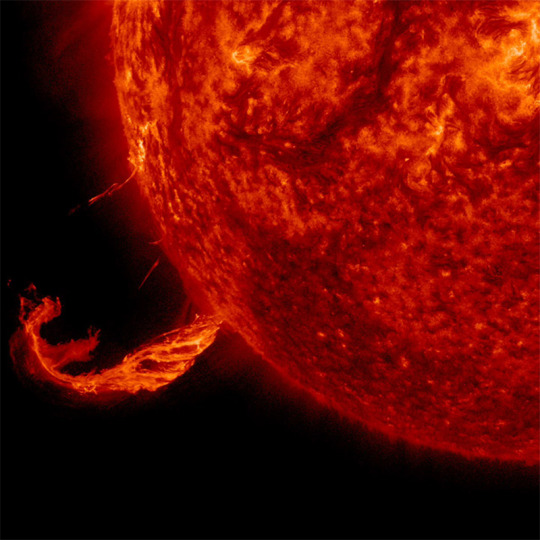#Stars ⭐️ | Turbulent Flows | Charged Particles
Explore tagged Tumblr posts
Text

Image: Naeblys/Shutterstock
The Sneaky Force Behind Our Sun’s Violent Outbursts! A Strange Discovery From Flying Close To The Sun.
— By Paul M. Sutter | September 23, 2023 | Nautilus
Many of the mysteries of our sun are not buried at its core, as we might expect. They are dancing ferociously on its surface. Plasma leaps out, arcing millions of miles into space before plunging back to return to its fiery home. Massive solar flares shoot deadly X-ray radiation into the solar system. And coronal mass ejections loft chunks of the sun’s own body into space, creating storms of energy that can wreak havoc on the planets in our solar system.
For millennia, astronomers marveled at the displays, puzzling over what might be causing them. But marvel was about all they could do. The shows of force could usually only be glimpsed, briefly, during a total solar eclipse, when the moon blocked the body of the sun and the sun’s corona—its outermost atmosphere—and wild prominences became visible.
Now, however, scientists have sealed the wax on their proverbial wings and are flying ever-so-close to the sun, able to witness its atmosphere and study it directly in all its fiery glory.
The Parker Solar Probe Had To Take An Icarian Risk.
After launching in 2018, NASA’s Parker Solar Probe has been flinging itself around Venus, using the planet as a sink of gravitational energy to draw the probe closer and closer and closer to the sun’s chaos. Joined by the ESA’s Solar Orbiter, which launched in 2020, the bold pair have been beaming back astonishing evidence about what is driving the sun’s high-energy fury. The results suggest that it is not plumes of combusting fire or the violent strikes of meteors, as earlier astronomers had once suggested, but more likely a humble, unassuming, usually ignored force in the universe: magnetic fields.
As an astrophysicist, I have a soft spot for magnetic fields. They never truly get the attention they deserve. My own research has investigated the subtle role they play on the largest of cosmic scales. And I’ve learned over the years that when there is some process in the universe that you don’t fully understand, it’s worth taking a looking at magnetic fields. Because even though they’re weak, they’re often sneaky.
Magnetic fields are everywhere in the universe. Any time you take a collection of charged particles and accelerate them, the resulting electrical current generates the formation of an attendant magnetic field. Earth has charged particles whipping around in its molten core, and so magnetic fields wrap around our planet in a protective embrace. Clouds of forming stars have turbulent flows of charged particles, and along with them tangled, knotty magnetic fields. Even entire clusters of galaxies, the largest gravitationally bound structures in the universe, are home to magnetic fields stretching millions of light-years on a side.

Invisible Threads: New data from extreme solar missions are finding that typically weak magnetic forces might bundle together to drive the massive jets of plasma that leap from our sun’s surface. Credit: Solar Dynamics Observatory, NASA.
And yet for all this magnetic abundance in the universe, the fields themselves are one of the weakest phenomena in the natural world, so feeble they can almost always be ignored in any consideration of physics. They rarely play a starring role in astrophysical processes; they simply seem to exist as a happenstance.
On Earth, it takes the combined might of the entire molten core to generate a magnetic field strong enough to gently nudge a compass needle around. For any living creatures on Earth, with the exception of migratory birds and a handful other species, if we were to lose our magnetic field, we wouldn’t really notice it in the day-to-day. The same holds true for the vast majority of astrophysical cases: The magnetic fields are there, winding throughout the universe, but are relegated to the role of non-speaking background actors, not one of the main cast.
Our sun, being a giant ball of plasma, naturally has a magnetic field of its own. It’s not particularly strong, however, only roughly twice as strong as Earth’s, and less than a quarter the strength of Jupiter’s. And, honestly, even though magnetic fields are approximately everywhere in the universe, they don’t seem, usually, to do much of anything.
But for decades, some bold astrophysicists, like the pioneering Eugene Parker, for whom the Parker Solar Probe was named, suspected that magnetic fields might play an outsized role in the radical dynamics of the sun. And so, the Probe, along with the Solar Orbiter, were launched with instruments specifically designed to measure the strength and scope of the sun’s ever-changing magnetic fields. Combined with more traditional instruments, like heat-resistant telescope optics and particle detectors, the teams behind the missions hoped that the probes might alight on some strange, intricate connection between the sun’s magnetic fields and its awesome displays of raw power.
Magnetic Fields Can Twist And Bundle Themselves Together, Transforming From Weak Threads To Powerful Cables.
To accomplish this, the Parker Solar Probe had to take an Icarian risk. In April 2021, NASA’s Parker Solar Probe became the first instrument ever devised by human hands to “touch the sun,” sailing into its inferno of a corona, where temperatures soar to 2 million degrees Fahrenheit (200 times hotter than the surface of the sun itself). Whipping around our home star at a speed of more than 90 miles per second—also setting a record for the fastest spacecraft in history—Parker approached within about 6.5 million miles of the solar surface. Spending only a short time at that close distance on that pass, the Probe collected as much data as possible: mapping the solar surface, measuring the stream of high-energy particles traveling through the corona, and measuring the magnetic fields as they twist and wrap throughout the sun’s environment.
From this extreme front line, Parker has been beaming floods of data back to Earth, where scientists are still processing and analyzing them. What is becoming clear is that the sun’s magnetic fields are operating with an unusual superpower—one that enables them to leap from the background to become a major player on the stage of the sun. To speak and have strong opinions of their own. To transform and shape the worlds around them.
We are learning that when it comes to the surface and atmosphere of the sun, magnetic fields are usually quiet. But when they speak their minds, we can’t ignore them.
The superpower is this: Magnetic fields, though typically humble on their own, under the right conditions can twist and bundle themselves together, transforming from weak threads to powerful cables. These knotted, self-wrapped twines snake in and out of the solar surface, threading deep into the plasma heart of the sun and far out into the corona. Once in place, they become far stronger than average, no longer responding to the motions of the plasma around them, but instead directly their own flows.

Into The Fire 🔥: A new paper describes the Parker Solar Probe’s safe passage through a coronal mass ejection event—captured here in a burst of plasma from below. Credit: NASA/Johns Hopkins APL/Naval Research Lab.
We see this most clearly during the eruptions of solar prominences. When we observe the great arches of plasma reaching out and back into the sun, we are witnessing the flow of superheated electrically charged plasma forced to follow the bundles of magnetic field lines.
The tangled mass of twisting magnetic field lines can, however, reach a critical breaking point. If the fields become too tightly woven, too constricted, then plasma piles up at either end. This drives the magnetic fields even tighter together, and eventually, if the pressure becomes too great, they snap. This snapping of the magnetic field releases an enormous amount of pent-up energy. First in the form of X-ray radiation—the solar flares. And if the magnetic bundles go deep enough into the bulk of the sun, it can lead to the launching of material along the broken lines of magnetism in the form of a coronal mass ejection, like the one Parker flew through last fall, described in a new paper.
With the Parker and Solar Orbiter, scientists have been able to watch these processes play out in real time. The collection of magnetic fields, the bundling together into thick ropes, the channeling of plasma, the storing of energy, and the ultimate release of the sun’s magnetic fury. Scientists have now been able to watch—close up—as kinks in the magnetic field lines zip up and down, in and out, transporting energy from the surface of the sun to the corona, heating it up. As the interior of the corona heats, the outer layers energize and detach completely, becoming the solar wind.
Space Weather Forecasts Are Essential to Protecting Our Satellite 🛰️ Infrastructure And Electricity Grids.
These aren’t just abstract explorations of some distant astronomical target. This is our sun—the source of all light and warmth here on Earth, as well as a source of potential danger. When solar flares erupt, the resulting X-rays bombard our planet. When coronal mass ejections race outward, they can fly in our direction.
Understanding the dynamics of the sun, especially the critical role that tangled magnetic fields play, can help us make better space weather forecasts. These forecasts are essential to protecting our satellite infrastructure—and even our Earth-based electricity grids and radio communications, whose weaknesses were evident during the especially strong solar storm in 1989. Right now, solar storm forecasts rely on constant observations of the sun’s activity, waiting for a burst to happen and sending out an alert. But often, we only know a storm is approaching after it’s already been launched from the sun, giving us just several minutes’ lead time. Understanding the role of magnetic fields can help us spot the precursors to a storm as it’s building, leading to longer warning times and a better sense of a particular storm’s anticipated severity.
But even with this newly emerging picture of the sun’s temperamental and powerful magnetic forces—and our increasing vulnerability to their whims—there is much more work to be done.
The Parker Solar Probe and Solar Orbiter will continue their dangerous missions for the next few years, observing carefully with each new eruption, each new storm, for the delicate lines of magnetic fields to conspire. As the Solar Orbiter continues to circle the sun from a comparably cool 26 million miles’ distance, the Parker will keep hurling itself around Venus to get closer and closer to the sun, with its next dip into the corona scheduled for next week, on September 27. By the time it sails its final pass, anticipated in December 2025, it is expected to travel within 4 million miles of the sun’s surface before running out of fuel. From all of these flybys, data will be mounting for scientists to sift through and make sense of over years—and likely decades—to come.
Next year, the ESA hopes to launch Proba-3, an experimental mission to test a new kind of multi-satellite formation that could deliver even more details about the sun’s tumultuous outer layers. Combined with dedicated ground-based observatories, astronomers hope to continuously monitor the sun in as many ways as possible, to further elucidate the complex and ever-changing relationship between magnetic fields and the solar plasma that births them and can then be controlled by them.
Far from any mechanical forces envisioned by early astronomers, the driving forces of the sun’s powerful displays are typically so quiet that they eluded suspicion for centuries. And hopefully, with even more daring missions in the future, humanity will continue to unravel more mysteries of the unseen power of magnetism in our universe.
#Astronomy#Sun’s Violent Outbursts#Sneaky Force#Nautilus#Paul M. Sutter#NASA’s Parker Solar Probe#ESA’s Solar Orbiter#Universe | Magnetic Fields#Stars ⭐️ | Turbulent Flows | Charged Particles#X-Ray 🩻 Radiation ☢️#Scientists#Satellite 🛰️#Space Weather Forecasts#Planet Earth 🌎#Proba-3#Hope | Daring Missions | Future#Future | Humanity#Mysteries | Unseen Power | Magnetism
0 notes